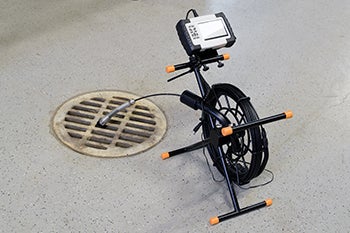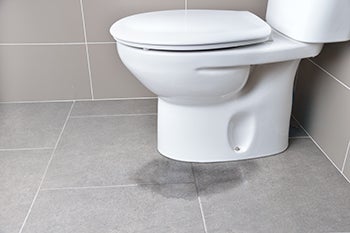You may need to move fast in the current home-buying market, but don't overlook these plumbing red flags that could cost you later.
There are many things to take into account when buying an existing home. Plumbing is considered a major factor because of what repairs and replacements can cost you down the road. Here are a few areas to check while touring a home that could save you major plumbing expenses later.
1. The water distribution system
Typically found in the basement or mechanical room of the home, the water distribution system is where you'll find the main shut-off valve. It also connects to the water meter, which measures the amount of water used in a household. We recommend visually inspecting the whole system and any exposed pipes.
Main water valve: This turns off all water to the entire home. When checking for issues here, turn it off and open up the plumbing fixtures around the house. They should drain down and, eventually, the water should stop. If it doesn't, then the main water valve is not creating a positive seal and needs to be replaced.
Pipes: Any exposed pipes or water supply lines — usually made of copper, PEX, CPVC, or galvanized steel — should be visually inspected. A big red flag here is if the system consists of galvanized pipe. These pipes may need to be replaced due to the high probability that there is corrosion buildup on the inside of the pipe. For other pipe types, look for leaks around the joints, look for corrosion, or watermarks. You can also check for leaks by seeing water actually dripping from the pipe or looking for water that has accumulated on the floor.
For leaks that are hidden, check the water meter to see if it is still spinning while all the faucets are closed. In homes built on slab foundations, this leak may be underneath the home. In that situation, we recommend calling a plumbing professional to test the water lines and determine the source of the leak.
Water pressure: By turning on all the fixtures in the home simultaneously, you can check the water pressure. If the pipes are sized properly, you should have a minimal decrease in pressure. Depending on the plumbing code in your area, a typical pipe diameter would be ¾-inch for the main water service line and supply branches and ½-inch for each fixture supply. That would get you the recommended amount of pressure for each fixture in most cases. Number of bathrooms, number of stories, the square footage of the home, and incoming water pressure are also important factors to consider for this to be true.
2. Drain, waste and vent system (DWV)
Also known as the sanitary system, the DWV system is the drainage system which consists of waste and vents. Waste pipes keep the house clean and sanitary by carrying solids and liquids away from the home to be treated. Vent pipes help maintain the trap seals at the fixture drains by maintaining an equalized pressure and prevent siphoning so sewer gases will not escape into the home.
Drainage waste: To check each of the drains in the home, open up a faucet to see if the sink is draining properly. If there is any standing water, there is probably blockage somewhere in that area. Another indication of blockage is if you flush the toilet, and the water begins to fill the bowl.
Pro tip: Be sure the current homeowners have their main sewer line camera-checked to disclose any breakage, blockages, or roots growing within the drainage line. It is extremely important to do this to prevent potential problems — and heavy expenses — later on.

Vent pipes: Your senses will come in handy when checking vent pipes. If you smell any sewer gases while walking around the home, or hear any gurgling while fixtures are draining chances are there’s a blockage in your vent. When you turn on the water, listen for gurgling and watch for pockets of air being released. Think of the vent like a straw in a glass of liquid with your finger over the end. The liquid in the straw will remain or drain slowly until your finger is removed. If a blockage is present, the trap seals at the fixture could siphon and allow sewer gas to escape.

3. Plumbing fixtures and appliances
You will find many plumbing fixtures and appliances throughout the home. Whatever the type or model, checking to see if they have been installed properly and are still functional will be important in determining the need for a replacement.
Water heater: This can be one of the most costly replacements of all the appliances in the home. You should inspect the water heater for rust, anything at the bottom of the unit (if it is a standard storage tank-type), and the hot- and cold-water connections at the top.
Also, check the manufacturing date on the sticker. A typical life expectancy is around ten years. Two big red flags that something is wrong: 1) the hot water supply is exhausted quickly; or 2) rust is coming from the faucets, usually caused by sediment buildup in the water heater.
Toilet: When checking this appliance, look for any leaking around the base. Also, inspect the ceiling of the room one floor below the bathroom for any discoloration or stains caused by a leaking toilet above. If the toilet bowl is wobbly or leaking, this could be a sign of a damaged toilet flange or failing wax ring. Depending on how damaged the toilet is, these are easy repairs that can be done by a licensed plumber.

Understanding how the plumbing works and what little things to notice can be a huge relief when deciding on this big investment. Be sure to work with a plumbing professional if you spot any of the red flags mentioned above. A professional plumber can further inspect the plumbing and determine whether there is a serious issue.
Interested in learning more about how a home plumbing system works and ways to prevent major problems? Check out our blog, "Plumbing 101: Homeowner Plumbing Overview."